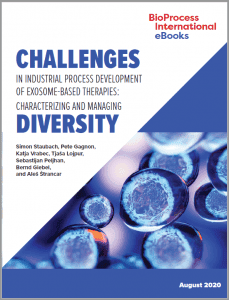eBook: Challenges in Industrial Process Development of Exosome-Based Therapies: Characterizing and Managing DiversityeBook: Challenges in Industrial Process Development of Exosome-Based Therapies: Characterizing and Managing Diversity
 The traditional classification of extracellular vesicles (EVs) includes three types: exosomes, microvesicles, and apoptotic vesicles. Each type arises from a distinct origin and exhibits distinct characteristics. The problem is that their size ranges overlap and that the major surface proteins presented by exosomes also are present on the surfaces of microvesicles and apoptotic bodies. This makes it a challenge for process developers to identify the vesicle fraction that best serves a particular exosome therapy. Anion-exchange chromatography (AEC) can fractionate EVs into populations of different composition. This article highlights the complementarity of two analytical methods for characterizing distinctions among EV populations separated by AEC: imaging flow cytometry (IFCM) and size-exclusion chromatography.
The traditional classification of extracellular vesicles (EVs) includes three types: exosomes, microvesicles, and apoptotic vesicles. Each type arises from a distinct origin and exhibits distinct characteristics. The problem is that their size ranges overlap and that the major surface proteins presented by exosomes also are present on the surfaces of microvesicles and apoptotic bodies. This makes it a challenge for process developers to identify the vesicle fraction that best serves a particular exosome therapy. Anion-exchange chromatography (AEC) can fractionate EVs into populations of different composition. This article highlights the complementarity of two analytical methods for characterizing distinctions among EV populations separated by AEC: imaging flow cytometry (IFCM) and size-exclusion chromatography.
Fill out the form below to read the complete eBook and learn more about exosome therapy now.
You May Also Like






